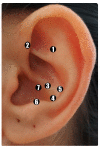Development and Validation of an Auricular Acupuncture Protocol for the Management of Chemotherapy-Induced Nausea and Vomiting in Cancer Patients
- PMID: 38255105
- PMCID: PMC10815809
- DOI: 10.3390/healthcare12020218
Development and Validation of an Auricular Acupuncture Protocol for the Management of Chemotherapy-Induced Nausea and Vomiting in Cancer Patients
Abstract
Auricular acupuncture (AA) has been used to manage chemotherapy-induced nausea and vomiting (CINV). However, the application of the technique varies widely among the clinical trials that test its effectiveness. The aim of the present study was to develop and clinically validate an AA protocol for the management of CINV in cancer patients. This study was carried out in two stages: (1) development of the AA protocol for the management of CINV and (2) clinical validation of the protocol. The content validity of the protocol was determined by a panel of specialists, with an agreement rate ranging from 85.7% to 100%. In the clinical validation, when administered to cancer patients, the protocol developed has been shown to reduce the incidence, frequency, severity, and length of nausea and vomiting following chemotherapy, as well as the severity of nausea and anticipatory nausea following chemotherapy. This protocol needs to be tested in future studies, including a pilot study with a sham group and a randomized clinical trial, in order to further evaluate its feasibility, acceptability, safety, and clinical usefulness for the management of CINV.
Keywords: auricular acupuncture; content validity; development and evaluation; nausea; oncology; palliative care; vomiting.
Conflict of interest statement
The authors declare no conflicts of interest.
Figures

Similar articles
-
Development and validation of an evidence-based auricular acupressure intervention for managing chemotherapy-induced nausea and vomiting in breast cancer patients.Complement Ther Med. 2020 Aug;52:102502. doi: 10.1016/j.ctim.2020.102502. Epub 2020 Jul 3. Complement Ther Med. 2020. PMID: 32951751
-
Effects of auricular acupressure on chemotherapy-induced nausea and vomiting in breast cancer patients: a preliminary randomized controlled trial.BMC Complement Med Ther. 2022 Mar 24;22(1):87. doi: 10.1186/s12906-022-03543-y. BMC Complement Med Ther. 2022. PMID: 35331208 Free PMC article. Clinical Trial.
-
Efficacy of Auricular Acupressure in Prevention and Treatment of Chemotherapy-Induced Nausea and Vomiting in Patients with Cancer: A Systematic Review and Meta-Analysis.Evid Based Complement Alternat Med. 2021 Aug 3;2021:8868720. doi: 10.1155/2021/8868720. eCollection 2021. Evid Based Complement Alternat Med. 2021. PMID: 34394394 Free PMC article. Review.
-
Reduction in nausea and vomiting in children undergoing cancer chemotherapy by either appropriate or sham auricular acupuncture points with standard care.J Altern Complement Med. 2012 Apr;18(4):334-40. doi: 10.1089/acm.2011.0102. J Altern Complement Med. 2012. PMID: 22515794 Clinical Trial.
-
Music interventions for chemotherapy-induced nausea and vomiting: a systematic review and meta-analysis.Support Care Cancer. 2020 Sep;28(9):4031-4041. doi: 10.1007/s00520-020-05409-w. Epub 2020 Apr 23. Support Care Cancer. 2020. PMID: 32328772
Cited by
-
Multi-level exploration of auricular acupuncture: from traditional Chinese medicine theory to modern medical application.Front Neurosci. 2024 Sep 23;18:1426618. doi: 10.3389/fnins.2024.1426618. eCollection 2024. Front Neurosci. 2024. PMID: 39376538 Free PMC article. Review.
References
-
- Patel P., Robinson P.D., Wahib N., Cheung P., Wong T., Cabral S., Parker A., Cohen M., Devine K., Gibson P., et al. Interventions for the prevention of acute phase chemotherapy-induced nausea and vomiting in adult and pediatric patients: A systematic review and meta-analysis. Support. Care Cancer. 2022;30:8855–8869. doi: 10.1007/s00520-022-07287-w. - DOI - PMC - PubMed
LinkOut - more resources
Full Text Sources

